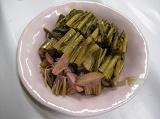Sunki
| Registration Number | 34 |
|---|---|
| Name of the GI | Sunki |
| Class | Processed Foodstuffs |
| Date of Protection | 2017/05/26 |
| Producing Area |
Nagano Prefecture
Kiso Town, Agematsu Town, Nagiso Town, Kiso Village, Otaki Village, Okuwa Village and all in Kiso District, and a part of Shiojiri City, Nagano Prefecture |
| Applicant - Name and Address | Sunki Brand Promotion Association To the attention of Agriculture Division, Kiso Regional Department, Nagano Prefecture Office, 2757-1 Fukushima, Kiso Town, Kiso District, Nagano Prefecture, 397-8550, Japan |
Sunki is a traditional food that has long been passed down to Kiso-gun, Nagano Prefecture. It uses stems, or stems and leaves, of red turnip which is a traditional vegetable in this area, and is fermented with several types of plant lactic acid bacteria. It is considered to be the only pickle made with lactic acid bacteria. It is a very rare "non-salt" fermented lactic acid product both domestically and internationally.
The appearance of Sunki is similar to that of pickled nozawa-na from Nagano Prefecture, although it has an amber color. The flavor has a distinctive sour taste due to fermentation of the lactic acid bacteria and it may be eaten as it is, but in Kiso-gun, it has long been eaten as Sunki soup where Sunki is added as an ingredient to miso soup, and Sunki soba where hot soba noodles are topped with Sunki.
Sunki is made by blanching the stems or the hypocotyl of the red turnips, adding the seeds (ferment), and then pickling. Seeds from previous years have been handed down from generation to generation. It is thought that during this process, lactobacillus which perform good fermentation came to inhabit the area, and gave rise to Sunki. After pickling, it is kept warm for about one day, and when good fermentation is observed, it is transferred to a cold place and allowed to ferment slowly.
Sunki originated at a high altitude of 1,000 to 1,300 m in a very cold, harsh region, which is thought to affect the quality of the red turnips that are its raw material. It is known from experience that to make delicious Sunki, there should be once or twice of frosts around October to November just before entering the harvest season.
Sunki is a traditional food that has been consumed daily from the Edo period (1600 to 1868) up to the present. It is thought that it became popular in olden times, when salt was precious, because it uses lactic acid instead of salt to improve the preservability of vegetables that tend to be scarce in winter, deep in the mountains of Kiso in Shinshu. It was originally handed down as a "family taste", but in 1972, a pickle processing plant was constructed, and it has now been commercialized by the local agricultural cooperative association.


